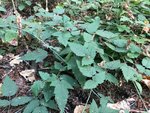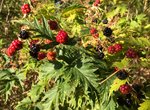


Yesterday a friend pointed out something I had never noticed: This is the time of year when Himalayan blackberry bushes – one of our most common invasive species – send out long, arching branches whose tips will touch the ground and grow roots.
In this way, blackberries march forward, eating up more space in any area where they can reach some sunlight.
Himalayan blackberries are controversial: Land conservationists hate them because they overwhelm and destroy native plant communities. Beekeepers love them because their flowers feed bees and make nice honey. Homeowners and farmers are in regular combat with them.
Then there are the disapproving blackberry gourmands. Fans of our native trailing blackberries (Rubus ursinus) turn their noses up at Himalayan berries, which they find rude, crude, and less tasty than the diminutive, harder-to-pick but less thorny natives.
There’s also a third species in the mix: Rubus laciniatus. It’s not native, and it’s classified as invasive, but it’s a lot less common and less aggressive than the Himalayans. It has prettier, more complex leaves and slightly smaller berries.
Both Himalayan and r. laciniatus are listed by the State Noxious Weed Control Board as “Class C” weeds, which is a category that kinda means “We’ll never get rid of all of this, but we should still try.” It’s the same category that Scotch broom is in. The best we can do is keep invasives like these out of sensitive areas like stream banks and nature preserves – and our yards, pastures, and gardens.
One problem with trying to eliminate rampant blackberry plants is that their seed germination is aided by birds and other wildlife. The Washington Noxious Weed Control Board reports that “Germination has been reported to increase by 30% after passing through the guts of birds and mammals.” So even if you think you’re safe, a bird flying overhead may poop out seeds that attempt an invasion in your shrubbery. And, as a keenly observant friend notes, blackberry seeds are also prominent in coyote scat this time of year. No place is safe.
We have none other than Luther Burbank to thank for importing Himalayan blackberries to North America. (No one seems to know how they got their name, since they originated in Armenia; hence their formal name, Rubus armeniacus.)
So you may think unkind thoughts about Luther Burbank if you are trying to get rid of them.
Eradicating a patch of Himalayan blackberries is an arduous, three- or four-year project of cutting them down and digging up their roots, which grow halfway to China. Victory is hard-won and must be followed by annual skirmishes to prevent their resurgence from the inevitable root fragments left in the ground. The only alternative is herbicides, and even that is also a multi-year project.
However, hand-to-vine combat is a great way to work out rage, frustration, anxiety, and resentment. Like whatever vexes you, blackberry vines are cruel, sharp, sneaky backbiters that arguably deserve destruction.
Still, I am quite fond of Himalayan blackberries. I admire their spunk, spirit, and wildly successful ability to spread far and wide and feed bees, coyotes, and other critters. I used to enjoy watching my horse – which had remarkably flexible lips – pick and eat them without getting thorn pricks. A neighbor’s dog has the same skill. And while I was out picking some a couple of years ago, a young buck seemed quite comfortable lip-picking his share just a few yards away.
But I’ve also geared up with sharp tools and thick gloves and cleared my share to make room for a big vegetable garden. I cut, whacked, and dug them out without a single pang of guilt. In fact, it made me feel like Wonder Woman, bringing order out of chaos.
It was obvious then and is obvious now that even our most heroic blackberry eradication successes will always be small – because the reach of those arching vines touching the ground and growing roots will always be long.
And so, eleven months from now, no matter how many battles in the war against Himalayan blackberries are fought, there will still be plenty for pie, jams, jellies, and grazing animals like us.
Jill Severn writes from her home in Olympia, where she grows vegetables, flowers and a small flock of chickens. She loves conversation among gardeners. Start one by emailing her at jill@theJOLTnews.com
2 comments on this item Please log in to comment by clicking here
Digger
Good news, you don't need to dig out all of the roots to get rid of blackberries. Just dig out the knob where roots and stalks come together.
Saturday, September 24, 2022 Report this
DeaneTR
As far as aggressive weeds go, primary stem density of blackberry is very sparse compared to almost any other weed. Clearing an entire area of blackberry is indeed a multiyear project, but once you get into clearing the initial canes with plans to return later to dig up the primary root balls, there's not that many rootballs because just one small root ball can cover over a 15 foot diameter area in just a couple years.
When I bid gardening jobs the blackberry removal estimates are far fewer hours of work than many other invasives. And compared to digging up european grasses by the roots, blackberry removal is super easy and doesn't take long.
Tuesday, September 27, 2022 Report this